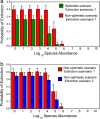Colloquium paper: how many tree species are there in the Amazon and how many of them will go extinct?
- PMID: 18695228
- PMCID: PMC2556410
- DOI: 10.1073/pnas.0801915105
Colloquium paper: how many tree species are there in the Amazon and how many of them will go extinct?
Abstract
New roads, agricultural projects, logging, and mining are claiming an ever greater area of once-pristine Amazonian forest. The Millennium Ecosystems Assessment (MA) forecasts the extinction of a large fraction of Amazonian tree species based on projected loss of forest cover over the next several decades. How accurate are these estimates of extinction rates? We use neutral theory to estimate the number, relative abundance, and range size of tree species in the Amazon metacommunity and estimate likely tree-species extinctions under published optimistic and nonoptimistic Amazon scenarios. We estimate that the Brazilian portion of the Amazon Basin has (or had) 11,210 tree species that reach sizes >10 cm DBH (stem diameter at breast height). Of these, 3,248 species have population sizes >1 million individuals, and, ignoring possible climate-change effects, almost all of these common species persist under both optimistic and nonoptimistic scenarios. At the rare end of the abundance spectrum, however, neutral theory predicts the existence of approximately 5,308 species with <10,000 individuals each that are expected to suffer nearly a 50% extinction rate under the nonoptimistic deforestation scenario and an approximately 37% loss rate even under the optimistic scenario. Most of these species have small range sizes and are highly vulnerable to local habitat loss. In ensembles of 100 stochastic simulations, we found mean total extinction rates of 20% and 33% of tree species in the Brazilian Amazon under the optimistic and nonoptimistic scenarios, respectively.
Conflict of interest statement
The authors declare no conflict of interest.
Figures







Comment in
-
Unrealistic assumptions invalidate extinction estimates.Proc Natl Acad Sci U S A. 2008 Dec 23;105(51):E121; author reply E122. doi: 10.1073/pnas.0808335106. Epub 2008 Dec 16. Proc Natl Acad Sci U S A. 2008. PMID: 19088186 Free PMC article. No abstract available.
References
-
- Pires JM, Dobzhansky TH, Black GA. An estimate of the number of species of trees in an Amazonian forest community. Bot Gaz. 1953;114:467–477.
-
- Whitmore TC, Sauer JA, editors. Tropical Deforestation and Species Extinction. London: Chapman & Hall; 1992.
-
- Laurance WF, et al. The future of the Brazilian Amazon. Science. 2001;291:438–439. - PubMed
-
- Laurance WF, et al. Issues in Amazonian development. Science. 2002;295:1643–1644. - PubMed
-
- Ecosystems and Human Well-Being. The Millennium Ecosystems Assessment. United Nations, New York: UNDP; 2006. Anonymous.
Publication types
MeSH terms
LinkOut - more resources
Full Text Sources
Other Literature Sources
Miscellaneous

